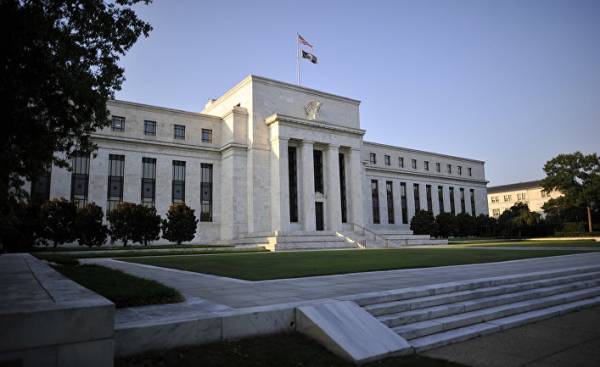
Since late 2008, when the first round of large scale asset purchases under the so-called QE (Quantitative Easing), the fed’s balance sheet has increased from 900 billion to over 4.4 trillion dollars. And although members of the Federal reserve promised to reduce it when the economy recovers, our big fat Federal reserve continues to stay the same fat.
In recent years some of the presidents of the Federal reserve urged him to begin to fulfill his promises. The Federal reserve is to listen; and the same applies to Congress. There is nothing “normal” about balancing the fed’s $ 4.4 trillion, respectively, or its inflated impact on the credit system of America. This inflated effect — bad news for the American economy, because it means that a large chunk of government savings, which could help to revive the flagging performance, but instead goes to the government and its agencies.
Before the mortgage crisis, banks kept a very modest balances in the Federal Reserve. To deal with sometimes associated with deficits, they quickly took the funds from the reserves or from the “Federal funds” in the so-called rates of the Federal Fund (the”fed”). Monetary policy was reduced to that of deciding at which level shall be the Federal funds rate if the fed intends to achieve the desired level of inflation and unemployment, as well as to regulate the flow of Bank reserves to the real fed funds rate has reached the selected target level.
As banks in the pre-crisis arrangement was satisfied with only modest reserves, almost every dollar in a Bank Deposit went to Finance Bank loans issued to businesses or consumers, and the credit impact of the Federal reserve, respectively, was insignificant. Total assets of the Federal reserve amounted to only 1/8 of the assets of all U.S. commercial banks. In other words, the fed was able to control the whole process of granting loans, but it gave commercial banks to determine where you need to go these loans. During the financial crisis everything has changed and the fed is not without difficulty, but he succeeded in creating an entirely new order, which exists at the present time.
In October 2008, the Federal reserve, worried that his emergency measures on lending will reduce the Federal funds rate, and they will be below the target level, started to pay interest on excess reserves (IOER), and as a result, banks began to accumulate reserves, rather than to provide loans to other banks. Thanks to Quantitative easing, banks have been able to accumulate $ 2.7 trillion in excess reserves.
Although the interest on excess reserves allowed banks to accumulate reserves, he couldn’t keep from falling the rate on Federal funds, and in the end, she began to aspire to zero. To support the fed introduced the second tool — Agreement about the one-day repurchase (Overnight Reverse Repurchase Agreements), which allowed to pay the percentage of nonbank financial firms placed so their cash. Rate Agreement on one-day repurchase sets the lower limit that was the intended “level” of the Federal funds rate. It also meant that the fed requisitioned loans not only from banks but also other financial institutions.
All this caused a crisis of innovation turned out to be the Federal reserve, control over which loans in the state has increased significantly. When compared with the us commercial banking system, the fed is currently four times more than what it was before the crisis. Bank reserves, which previously accounted for a modest fraction of a percent of total Bank deposits now make up a fifth of these deposits. Bank lending to businesses and consumers, which is formally accurate to the dollar is equal to Bank deposits, today is only 80 cents of every dollar. The rest goes to the Federal reserve, and from there to the government and other agencies whose securities the fed buys.
Central banks are forcing commercial banks to send them a significant amount of their meager savings, and this is nothing new. The Central banks of less developed countries often do. When they do, economists called their actions “financial repression”. According to these economists, it’s an important reason why many poor countries remain poor. And now the fed is engaged in financial repression, hidden under the guise of high-tech monetary policy. While the American economy suffers accordingly.
That’s why right-those employees of the Federal reserve who want to restrict the activities of the Federal reserve sooner rather than later. If employees of the Federal reserve can’t convince him that we need to start to decline, then the Congress must force him to do it. It can add a provision to the new Law on financial choices (Financial CHOICE ACT 2.0) and set a deadline for reducing its balance sheet of the Federal reserve. Would be even better if the Congress will include a call for the gradual elimination of the payment of interest on excess reserves, as well as the agreement on one-day repurchase.
Although some staff of the Federal reserve will undoubtedly protest and say that such actions mean violation of the principle of the independence of the Federal reserve, the Congress should not consider such complaints. The fed’s mandate calls on it to ensure that he managed the provision of credit in the country and achieved the most stable prices and full employment. He did not give it the ability to compete with private sector creditors in the fight for a large chunk of national savings. If the fed would resist reduction of their mission, Congress has not only the right but the duty to put an end to it.
George Selgin is a senior fellow and Director of the Center for monetary and financial alternatives (Center for Monetary and Financial Alternatives) Cato Institute (Cato Institute).







